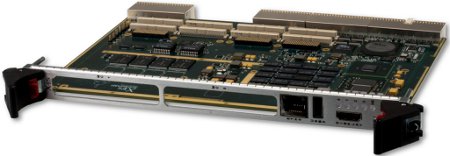cPCI board offers Core i7 CPUs, ruggedization options
Nov 1, 2010 — by Eric Brown — from the LinuxDevices Archive — 2 viewsExtreme Engineering Solutions (X-ES) is shipping a conduction- or air-cooled 6U CompactPCI single board computer (SBC) based on the Intel Core i7 processor. The XCalibur4301 offers up to 16GB of DDR3 SDRAM, three gigabit Ethernet ports, thee USB 2.0 ports, dual DVI ports, plus a choice of three levels of ruggedization.
The XCalibur4301 targets upgrades to existing commercial, industrial, and military 6U CompactPCI applications, says X-ES. Board support packages are offered for Linux, VxWorks, QNX Neutrino, and Integrity. Windows drivers are also available, says the company.
In September, X-ES announced a 3U CompactPCI (cPCI) board based on a Freescale QorIQ P4080 system-on-chip (SoC), called the XPedite5430. The company's latest cPCI board instead opts for the Intel Core i7, the most powerful of a number of embedded, 32nm-fabricated Core processors Intel announced in January. (Other recent 6U cPCI boards equipped with the Core i7 include the Adlink cPCI-6510 and the Kontron CP6002.)

XCalibur 4301
(Click to enlarge)
The XCalibur4301 is equipped with a cPCI site supporting PICMG 2.1, 2.3, 2.9, and 2.16 standards. Also available is a PMC site and a XMC site (see block diagram and spec list farther below).

XCalibur4301 block diagram
(Click to enlarge)
Three levels of ruggedization are available, with different levels of temperature, shock, and vibration resistance. The highest level offers support for operating temperatures of -40 to 185 deg. F (-40 to 85 deg. C), says the company.
Features and specifications listed for the XCalibur4301 include
- Processor — Intel Core i7-610E (2.53GHz), -620LE (2.0GHz), and -620UE (1.06GHz); Intel QM57 chipset
- Memory — up to 16GB DDR3-1066 ECC SDRAM via 2 x 8GB channels
- Flash memory — up to 128GB NAND flash; 32MB NOR flash
- cPCI expansion:
- 66MHz 64-bit PCI interface to J1 and J2
- PICMG 2.1 (hot swap support)
- PICMG 2.3 (PMC I/O to P3 and P5)
- PICMG 2.9 (dedicated IPMI controller)
- PICMG 2.16 (2 x gigabit Ethernet)
- PMC site — PCI-X (32/64-bit, 66/100-MHz); PCI (32/64-bit, 33/66-MHz)
- XMC site (VITA 42.3) — x1, x2, x4, x8 links supported; full-duplex 5 GT/s lanes
- Networking — 3 x gigabit Ethernet ports (1 x front-facing)
- Other I/O:
- 2 x DVI ports (1 x front-facing, configured for HDMI)
- 3 x USB 2.0 ports (1 x front-facing)
- 1 x I2C interface
- 1 x SATA interface
- Power requirements — 50 W (2.53GHz)
- Operating temperature — three levels up to -40 to 185 deg. F (-40 to 85 deg. C); conduction or air-cooled
- Vibration resistance — up to 0.1 g(2)/Hz max.; 5 to 2000Hz
- Shock resistance — up to 40 g, 11ms sawtooth
Availability
The XCalibur4301 is shipping now, says X-ES, at an undisclosed price. More information may be found here, and in a PDF datasheet, here.
This article was originally published on LinuxDevices.com and has been donated to the open source community by QuinStreet Inc. Please visit LinuxToday.com for up-to-date news and articles about Linux and open source.